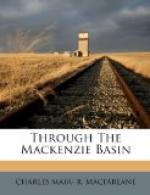To the north spreads upward, and backward to its summit, the vast bank of the river, varied as to surface by rounded bare hills and valleys and flats sprinkled with aspens, cherries, and saskatoons, the latter loaded with ripe fruit.
The banks of the Peace River are a country in themselves, in which, particularly on the north side, numerous homesteads might be, and indeed have been, carved out. Descending to the river, we found a Hudson’s Bay Company and Police post. The river here is about a third of a mile wide, and was in freshet, with a current, we thought, of about six miles an hour.
At Smoky River we met a couple of prospectors, Mr. Tryon, a nephew of the ill-fated Admiral, and Mr. Cooper Blachford, down from the Poker Flat mining-camp, this side the Finlay Rapids, in the Selwyn Mountains. They reached that camp by way of Ashcroft, B.C., in twenty-two days, the Peace River route being very much longer and more difficult. They described the camp there as a promising one, with much gold-bearing quartz in sight, but the cost of provisions and the extreme difficulty of development under the circumstances held it back.
There being but a few half-breeds here, we crossed the river, and decided to go on to Fort Dunvegan, and on our return complete our scrip issue at the Landing; so, partly on horseback and partly by waggon, we made our way to our first camp. The trail lay along and up and down the immense bank of the river, debouching at one place at the site of old Fort McLeod, and passing the fine St. Germain farm, with as beautiful fields of yellowing wheat as one would wish to see.
Here we got an abundant supply of vegetables, and in this ride our first taste of the Peace River mosquito—or, rather, that animal got its first taste of us. It is needless to dwell upon this pest. Like the fleas in Italy, it has been overdone in description, and yet beggars it.
All along the trail were old buffalo paths and willows. Indeed, we saw them everywhere we went on land, showing how numerous those animals were in times past. In 1793 Sir Alexander Mackenzie describes them as grazing in great numbers along these very banks, the calves frisking about their dams, and moose and red deer were equally numerous. In 1828 Sir George Simpson made a canoe journey to the Coast by way of this river, and they were still very numerous. The existing tradition is that, some sixty years ago, a winter occurred of unexampled severity and depth of snow, in which nearly all the herds perished, and never recovered their footing on the upper river. The wood buffalo still exists on Great Slave River, but, where we were, the only memorials of the animal were its paths and wallows, and its bones half-buried in the fertile earth.




